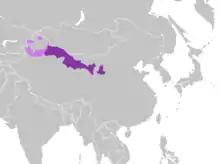Lanyin Mandarin
Lan–Yin Mandarin (Lanyin) (simplified Chinese: 兰银官话; traditional Chinese: 蘭銀官話; pinyin: Lán–Yín Guānhuà) is a branch of Mandarin Chinese traditionally spoken throughout Gansu province and in the northern part of Ningxia. In recent decades it has expanded into northern Xinjiang.[1] It forms part of Northwestern Mandarin, together with Central Plains Mandarin (Chinese: 中原官话).[2] The name is a compound of the capitals of the two former provinces where it dominates, Lanzhou and Yinchuan, which are also two of its principal subdialects.
| Lan–Yin Mandarin | |
|---|---|
| Region | Gansu, northern Ningxia, part of northern Xinjiang |
Native speakers | 10 million |
Sino-Tibetan
| |
| Language codes | |
| ISO 639-3 | – |
| ISO 639-6 | lyiu |
| Glottolog | xibe1241 |
| Linguasphere | 79-AAA-bg |
 | |
Among Chinese Muslims, it was sometimes written in the Arabic alphabet instead of Chinese characters.
The 14th Dalai Lama, Tenzin Gyatso, spoke the Xining dialect as his first language.
Major Subdialects
- Lanzhou dialect (simplified Chinese: 兰州话; traditional Chinese: 蘭州話)
- Urumqi dialect (simplified Chinese: 乌鲁木齐话; traditional Chinese: 烏魯木齊話)
- Xining dialect (simplified Chinese: 西宁话; traditional Chinese: 西寧話)
- Yinchuan dialect (simplified Chinese: 银川话; traditional Chinese: 銀川話)
References
- China - Page 902 Chung Wah Chow, David Eimer, Caroline B Heller - 2009 "Language Most of the population in Qīnghǎi speaks a northwestern Chinese dialect similar to Gānsù huà (part of the Lan–Yin Mandarin family). Tibetans speak the Amdo or Kham dialects of Tibetan. It's possible to travel almost everywhere using ..."
- Cahiers de linguistique, Asie orientale - Volumes 37-38 -2008 - Page 6 "兰银官话 Lányín Mandarin.."
This article is issued from Wikipedia. The text is licensed under Creative Commons - Attribution - Sharealike. Additional terms may apply for the media files.